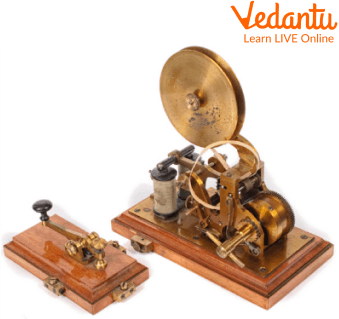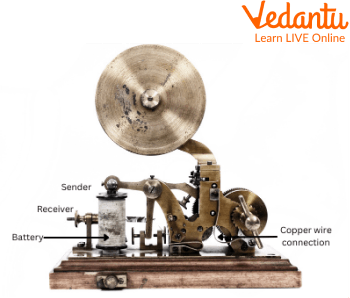




An Overview of Telegraph
Communication plays a vital role in everyone's life. People love to talk with each other through different modes of communication. One such mode of communication is Telegraph. Have you ever come through the word Telegraph? It involves sending messages through one set of telegraph instruments for sending and receiving information simultaneously. Let us discuss in detail how Telegraph works. First, let's have a look at what the telegraph looked like with the help of an image.

Telegraph
What is a Telegraph?
Telegraph can be defined as an electrical device which is used to send messages over long distances, Using wire that carries electrical signals. With the help of the Telegraph, we can send as well as receive messages. In ancient times Telegraph was the fastest mode of communication. The Telegraph was invented by Samuel Morse in the 1800s.

Samuel Morse
Thus we can say that the Telegraph is a communication system. Both senders, as well as receivers, should have a Telegraph to communicate with each other. Earlier people used to have telegraphs as it used to connect people.
How does the telegraph work?
Telegraph worked uniquely. Telegraph worked by sending an electric pulse, which varied in length and it further gets translated into text. To send and receive messages there need to be two telegraph machines. As a sender types out a message, the current into the wires closes the circuit. This further generates electricity as this current passes through the wire, it passes through the electromagnet that the receiver has and it further creates noise so the receiver can listen to the message. A Telegraph has both transmitters as well as a receiver. Wires connect the transmitter and receiver and thus a message is delivered from one end to the other.
Parts of a Telegraph Machine
Lets us first look after a pictorial view of parts of the telegraph machine:

How does a Telegraph Work?
A telegraph has a transmitter which has a transmission key. It also has a receiver, and wires which connect both the transmitter and receiver. It has an electromagnet which helps which is attached to a battery and through which current flows and the circuit if the wire gets completed and noise is created.
How to Make a Telegraph for Kids?
We can make Telegraph for kids at home in a fundamental manner. There are different things required to make Telegraph which are as follows:
9-Volt Battery
Copper Wire Nail
Pieces of Wood,
Thin copper plate,
Copper Screws.
To Make a Transmitter
Take one piece of wood of any measurements. Cut out a thin strip of bendable copper and then bend a portion of the copper upward. Place a screw under the bent end of copper, so that the copper will touch the top of the screw when pressed down.
To Make a Receiver
Nail 2 pieces of wood together into an L shape. Slightly hit a nail into the open side. Cut out another piece of bendable copper. Furthermore, Join one end of the coiled wire to the fixed end of the sender and the other end to one of the batteries. Connect the other battery terminal to the screw beneath the free end of the sender strip. In this manner, a telegraph can be made!
Telegraphic Language
Telegraphic language includes two words and a sentence, it has only the two most important words which explain the message. For example: “This shoe is wet “as it makes clear that the shoe is wet! “Cat sleep” makes clear that the cat is sleeping! It has short, simple sentences.
Summary
We have now seen how telegraph works and learnt about the telegraph. We can conclude that the telegraph was a big success and was an important system for communication from the 1800s to 2000. However, time passed and due to the advent of technology new inventions came up which replaced the telegraph but both electrical, as well as non-electrical telegraphs, played an important role. The parts of the telegraph machine are complicated. Telegraphs helped people to enjoy good communication as well as connectivity. And people enjoyed it as the telegraph was a cheaper mode of communication and people saved a lot of money! It covered a range of 250 miles! We hope you enjoyed reading this article, in case of any doubts, feel free to ask in the comments.
FAQs on Telegraph for kids
1. What are the negative aspects of the Telegraph?
The main disadvantage of the telegraph was that it lacked good communication quality, it lacked personal touch! Apart from this, its speed was also slow at times which further created hindrance in the mode of communication! Also, only four words were free and punctuation and other things to write in a message were expensive at times! Another backdrop was that as it created a message which has to be short enough only 2,3 words were there in a sentence. And overseas connectivity was lacking! Thus as every coin has two sides telegraph also has pros and cons!
2. What are the advantages of the telegraph?
Earlier as communication was a difficult task so telegraph invention helped people to enjoy talks with each other as it connected people through sending and receiving messages. Moreover it was a reliable mode of communication. Apart from this it also created job opportunities for people as it's not that easy great professionals and experts were needed so it created job opportunities for people, it was the efficient and cheaper mode of communication as it did not cost much to people to write 2,3 words in a sentence! It was even easy to operate.
3. Which other invention has replaced Telegraph?
In the 20th century, telegraph has been replaced by other different inventions. Inventions of telephone, Internet, and fax machines have replaced the use of telegraph and people started loving the new technology the more as compared to the Telegraph and the trend of Telegraph slowly and steadily started decreasing. The telephone has taken over the Telegraph and with help of the telephone people could enjoy communication as well as connectivity more randomly and instantly moreover there was no issue of range in using telephone so people enjoyed using telephone more as compared to the Telegraph.









